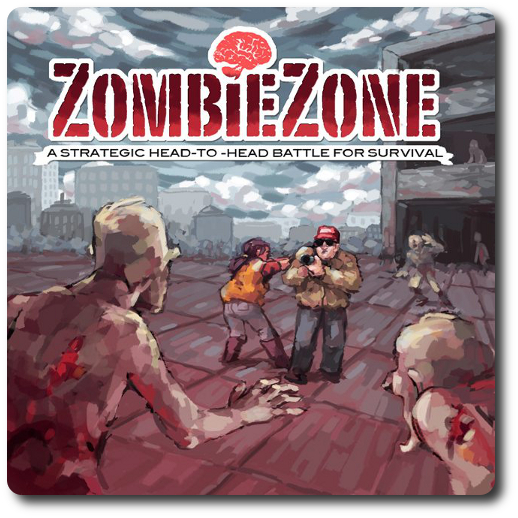
The Basics:
- For ages 5 and up (publisher suggests 12+)
- For 2 players
- Approximately 30 minutes
Geek Skills:
- Counting & Math
- Logical & Critical Decision Making
- Strategy & Tactics
- Risk vs. Reward
- Hand/Resource Management
- Worker Placement & Area Control
Learning Curve:
- Child – Easy
- Adult – Easy
Theme & Narrative:
- Welcome to the newest pop-culture television phenomenon: Undead Reality TV!
Endorsements:
- Gamer Geek rejected!
- Parent Geek approved!
- Child Geek approved!
Overview
The Zombie Invasion caught everyone by surprise. Despite the movies, the t-shirt slogans, and books that detailed how the zombies would attack and how to defend yourself, the population of the world shifted from alive and bored to undead and stiff. Once the initial shock wore off and the human race organized itself to fight and contain the zombie outbreak, life more or less returned to normal. Oh, sure, there were some changes. For example, EVERYONE now carried a handgun, graveyards had watchtowers, and the most popular TV show in history pitted willing living participants against mindless undead in a battle royal. In fact, you just signed a contract to be part of the next season, alive or undead. Good luck!
ZombieZone, by game designer Jason Tagmire (of Pixel Linconln fame), is comprised of 1 game board that depicts the arena floor, 20 Zombie/Human tokens (double-sided), 20 Ammo discs (red), 4 Bomb discs (blue), 4 six-sided die (2 black, 2 red), and 1 Shotgun die.
Pre-Show Checklist
Note: you are required to place the Zombie and Human stickers on the tokens and number values on the Shotgun die prior to your first game. This will take you all of about 5 or so minutes.
To set up the game, first place the game board in the playing area between the two players.
Second, choose which player will be the Zombies and which will be the Humans. Divide the Zombie/Human tokens evenly between both players (10 per player). The game rules suggest taking one of the tokens and flipping it as you would a coin to determine which player either selects first or which faction the player will take.
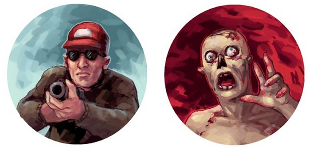
The tokens: Today’s Human is tomorrow’s Zombie
Third, there is no set “starting side” for Humans or Zombies as the game board is not meant to be symmetrical. Players should feel free to rotate the board however they like. Regardless of what side is used, players will place their tokens (with their specific faction facing up) on the edge of the board. There will be a square space for each of the tokens. The suggested first-time game board set up is shown below.
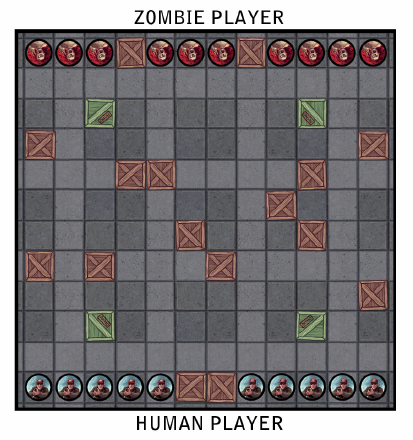
Fourth, the Zombie player should take the 2 black six-sided die and the Human player should take the 2 red six-sided die, the Shotgun die, the 20 Ammo discs, and the 4 Bomb discs.
Fifth, the Human player now places 2 Ammo discs on each of their Human tokens and 4 Bomb discs on 4 Human tokens of the player’s choice.
That’s it! Time to start the show! Choose who will go first if not already determined and begin!
Lights! Camera! Shotguns!
The game is played in rounds with each player taking a single turn per round. Both players only have two phases on their turn. These are move and attack. How the factions does either is dependent on if they have a pulse or not.
Phase 1: Move
The Zombie player will roll the 2 black six-sided die. The HIGHEST number rolled determines the maximum number of Zombies that can move this round. The LOWEST number rolled determines the maximum number of spaces the Zombies can move. For example, if the Zombie player rolled a “6” and “2”, this would mean that a maximum of 6 Zombie tokens can be moved a maximum of 2 spaces each. If the die values rolled are equal, then an equal number of Zombies will move an equal number of spaces.
The Human player will roll the 2 red six-sided die and their movement is exactly the same as a Zombie, but because the Humans have a working brain, they get to make a choice based on their rolled values. Like the Zombie player, one rolled value will determine the maximum number of Human tokens that can move this round and the other will determine the maximum number of spaces each token can move. The Human player, however, gets to decide. The HIGHEST value could be the total number of tokens moved or the number of spaces, for example.
Movement for both factions is always done orthogonally and never diagonally. A player is never forced to move any of their tokens, but if they do move them, they have to move at minimum of 1 space.
When a player only has one token left in play, they get the added bonus of an “Adrenaline Rush” that allows them to combine the two dice together to determine the number of spaces the lone unit can move (they can attack automatically). This bonus remains in effect for as long as the player has only one token in the game to use.
Phase 2: Attack
Technically, a Zombie attack happens at the same time as movement. Zombies bite and infect the Humans when they approach them. When a Human token is bit, it is flipped over and is now a Zombie token. Any Human token that is adjacent (orthogonally speaking) to a zombie is automatically and immediately flipped over. This can also cause a chain reaction that causes more than 1 Human token to be infected and flipped. Yikes! Luckily, a Zombie can only attack once, which means that if more than 1 Human token is adjacent to a single Zombie token, the Zombie player can only choose one of the Human tokens to attack. But, if the Human player moves one of their Human tokens adjacent to a Zombie token, the Zombie attacks automatically! This is bad news, indeed, especially if that Human token was carrying ammo or a bomb. If they were, the Human player removes the discs and places them on an adjacent and unoccupied space, where each space can only hold one disc each. If the space is occupied, the next space is used, and so on until all the items are dropped. The Ammo and Bomb can be recovered by another Human token.
Humans are a bit smarter but not as lethal. Humans, being cautious creatures, can move to a position that is best suited for them and then attack versus just blindly moving ahead. While this gives the Human player a distinct tactical advantage, it does not come without some inherent risk. The further away the targeted Zombie token is from the attacking Human token, the harder it is to drop the Zombie. This is because the Humans ares sporting shotguns. Terribly lethal at short-range, but less so the further out the target is.
Only the Human tokens that are activated can fire their shotgun and only then if they have an Ammo disc. To fire at a Zombie target, the Human player declares what Human token is attacking (with at least 1 Ammo disc attached), what Zombie token they are attempting to hit, and then rolls the Shotgun die. The rolled result shows the number of spaces that are in range for this attack. Unlike movement and Zombie attacks, shotguns can attack in all directions at once, both orthogonally and diagonally. If the rolled die value is equal to or greater than the number of spaces the targeted Zombie token is away from the attacking Human token, the Zombie token is removed from the game along with one Ammo disc. If the value rolled is not, the shot misses, but the Ammo disc is still removed. A roll of “X” is always a miss.
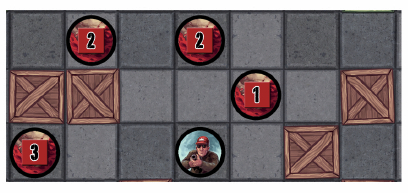
The number on each zombie indicates the range
The Playground
All the action takes place on the game board grid. Movement is tracked by moving across the grid on the squares. Occupying some of the square spaces are crates. Crates provide “high ground” for the Human player and give any Human token attacking from a crate a +1 to range, however, it costs 2 movement to climb on top of it. Moving from one crate to another and hopping down from a crate only costs 1 movement.
Humans can attack through crates and Zombies can attack Humans standing up on a crate, but cannot climb onto them. Sorry, Zombies, you have to shamble around those annoying wooden boxes. If a Human player moves a token on top of an Ammo crate, they can automatically refill their Ammo discs to no more than 2.
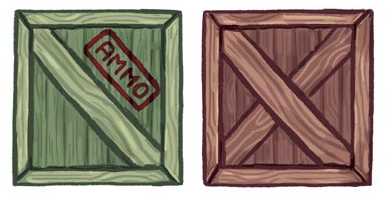
Ammo crate (left) and normal crate (right)
Endgame
The game can end one of two ways.
- The first player to eliminate all of their opponent’s tokens from the game wins. For the Zombie player, this means all the Human tokens have been turned to zombies, and for the Human player, all the Zombie tokens have been removed from the game.
- The Human player has deposited 1 Bomb on each of the 4 Ammo crates, in which case, the Human player wins. A Bomb disc can be dropped on an Ammo crate by simply moving a Human token onto it that is also holding a Bomb.
House Rule
The game plays just fine “as is”, but we have added a house rule for our little geeks that takes away some of the difficulty without reducing the fun. The Human players have to scrounge for ammo and this can be a difficult game mechanism for your little geek to grasp. Resource management is one of those Geek Skills that even Gamer Geeks still struggle with from time to time. If your little geeks wants to play as the Humans, put all the Ammo and Bomb discs in a central pile (we used a cup) and then have the little geek remove one Ammo disc each time they fire their shotgun. Having just one ammo pile to pull from reduces the need for the little geeks to conserve ammo as all the Human tokens share the central pile. They are still limited by total ammo available, but can collect 2 Ammo discs, putting them back in the pile, when a Human token stops on or moves on top of an Ammo crate.
To learn more about ZombieZone and read the full rules, visit the game’s web site on The Game Crafter.
Prediction
ZombieZone, just by reading the rules, appears to be a very simple 2-player game of area control. Each faction shares the same available actions, but how they go about those actions is different enough to warrant some speculation on game balance. My concern is that one faction will have a decisive and very obvious advantage over the other. Games, especially 2-player games, where one side is by default stronger, are not much fun to play. However, I do see a glimmer of game balance from just reading the rulebook. For example, zombie movement reduces the number of zombie attacks without reducing the attack’s effectiveness. Likewise, the human movement gives the player much more choice on where they want to go, but the need to move to reduce range puts the human player at risk of being eaten. These simple mechanisms already reveal that the game designer has put some thought into game balance. We’ll just have to play the game to see if it works.
The game doesn’t take long to teach, but special emphasis should be placed on the ammo limit and the bomb placement. We developed the noted house rule for our youngest players, but for everyone else, you just need to make sure that they understand that humans have a limited number of ammo and how they can get more. Not complicated, but essential to the Human player’s survival. After that, it’s pretty much just making sure everyone understands by what is meant by “adjacent”, “orthogonal”, and “diagonal”. One player was already confused when I showed them that a Human player could stand diagonally beside a Zombie token without fear of being bit. Again, all it took was a quick explanation and everything was set. But before we played our first game with our little geeks, I asked them their thoughts on the game so far.
“A very simple looking zombie game, but I love how the humans turn into zombies when they get bit!” ~ Liam (age 8)
“Daddy, can I be the Human player? I don’t want to be a Zombie. They are not nice monsters.” ~ Nyhus (age 5)
Looks like my little geeks are ready to go hunting! Let’s see if this game is an exciting match to the undeath!
Final Word
The Child Geeks really liked this game and found both factions to be a lot of fun to play. One little Child Geek said this game was like a better version of Checkers. To which we would agree. Any game that replaced abstract colored discs with shotguns and massive groups of undead is automatically a “step up”. Where the game really shined for my little geeks were how similar, but different, the two factions were. This made each game into something unique for them and guaranteed that their opponent wouldn’t just “copy” what they were doing (a big issue for the little geeks when it comes to Checkers and Chess). When the dust settled and the game was completed, both little geeks left the table feeling happy regardless of who won or who was eaten.
Parent Geeks, honestly, were not thrilled about the theme or narrative of the game. This put them at something of a distance right from the start. Once they played the game with their family members, they changed their minds. The games are fast and can be very intense without ever feeling weighty or unforgiving. Parents almost always took the role of the humans and the Child Geeks jumped at the chance to play the zombies. The game played very well between players with different skill levels and always felt balanced. The choices the player’s made had real impact in the game and the only time there was any analysis paralysis was when a Zombie player rolled 2 “6’s”. Turns out moving 6 Zombies at a time can be a logistical mess.
Gamer Geeks were torn on this one. They liked the theme but not the game play. The roll-n-move aspect reduced much of the strategy and tactics, leaving the game as nothing more than an exercise in limited decision making. Oh, they enjoyed the game, but their overall dislike of any game that trumped their ability to make tactical moves and choices simply because the dice didn’t roll the right way left a bad taste in their mouth. At most, they suggested this was a game they’d be happy to play if nothing else was available. One Gamer Geek said he was going to look into replacing his copy of Candy Land with ZombieZone. I imagine his little geeks will have nightmares in the future…

My little geek smirks as he gets ready to roll for his faction – he was really good with the shotgun!
Gamer Geeks, this is a very casual game that does require the player to use strategy and tactics, but not much. A great deal of the decision making is first based on the roll of the dice. Which tokens are moved and where are up to the player, but their choices are limited to the dice values rolled. This makes the game feel a bit too much like a “roll-n-move” experience and can turn off the most elitist of Gamer Geeks quickly. Look past this game mechanism and you’ll see a fun and fast 2-player game that sets up quickly and breaks down easily. Perfect for game fillers or whenever you feel like a quick zombiefest. The game was not accepted by the Gamer Geeks because of the “roll-n-move” like game mechanism, but don’t let that stop you from playing it with family and friends.
Parent Geeks, this is an easy to teach and easy to learn game of light strategy and tactics that reduces the player’s options to a subset of simple actions. While that might sound exceedingly basic, the area in which each player can move and the different way each faction operates, makes the game feel bigger and more difficult than it really is. If you don’t mind a slightly grotesque image of a zombie, you won’t have any problem playing this game. Some of the Parent Geeks thought the game was perfect for easy plays and introduction to more complex strategy games where location of pieces was very important to achieving victory. Non-gamer also enjoyed it, but didn’t comment for or against the theme.
Child Geeks, there are a lot of zombie games on the market. A lot. It’s one of those themes that you can slap on a game and it starts to sell before you can even get it on the shelves. However, most zombie games tend to put the player in a position where they must use a lot of tactics and strategy to keep their playing piece in the game. This usually also requires the player to go up against some incredibly poor odds of survival. This is the game’s intention and can feel very overwhelming, to say nothing of the stress the game play can produce. ZombieZone might stress you out a bit, but the game is not meant to be “hardcore”. You can pick a side, play a game within 30 minutes or less, and never feel like the game is getting out of control. Both sides are fun to play and act differently enough to make switching sides a worthwhile experience. This is especially true when neither side has any advantage over the other. Fast and fun, this is a great introduction to the more complex zombie-themed games you will doubtlessly play in your future.
I all kinds of disagree with the Gamer Geeks on this one, regarding endorsement. I play a lot of roll-n-move games with my little geeks, and while this game does require the player to roll the dice to determine movement, the dice values do not dictate or finalize a player’s actions. There is still a lot of thought that needs to go into the placement of the tokens. Zombies are great for simply just pushing forward and are much more effective if grouped together. Humans, on the other hand, have a much higher survival rate if they separate (which is completely contradictory to horror movie law). Each faction has their strengths and flaws, but the game is exceedingly well-balanced with the one exception being the dice rolls themselves. Depending on a player’s “luck”, they can get excellent rolls again and again. Just as likely, a player could also have really poor luck which will make their faction exceedingly ineffective. This was not lost on the Gamer Geeks and was at the root of their lack of endorsement. Any game that trumps or boosts a player’s natural gaming ability on a dice roll starts to feel very unfair and out of balance. But when we consider that the majority of dice rolls will not be in the extreme and the player gets to decide how to use them (tokens moved and spaces moved), the sense of being tied to the outcome of a single dice roll starts to feel less automatic and more strategic. Perhaps you want to move more tokens this turn instead of moving less spaces? Or, vice versa? Both options are available to the player and they are never forced to move any at all, if they don’t like. That’s why I can’t and won’t agree with the Gamer Geeks on this one, but I’m outnumbered regarding the endorsement level. At the very least, this is a game that is great for quick fillers and a wonderful introduction for new players (be they little geeks or adults just getting into the hobby) to zombie games were movement and location can make the difference between surviving or being lunch.
If you are looking for a quick game of zombie survival that is easy to teach, well-balanced, and perfect for those times when you “just want a quick game”, do lock your sights on ZombieZone. While not the most complex of zombie survival games on the market, it is certainly no cakewalk and was found to be much fun to play.
This game was given to Father Geek as a review copy. Father Geek was not paid, bribed, wined, dined, or threatened in vain hopes of influencing this review. Such is the statuesque and legendary integrity of Father Geek.




Eh… obviously, I’m a bit biased about this, but I feel that roll-and-move doesn’t really mean the same thing when you’re playing on a grid like this. In a game on a straight track, the yes, definitely, roll-and-move is total bummer. But in a game like ZombieZone, it is not a race; you’re not headed for a finish line. I feel as though roll-and-move in this context breathes some unpredictablility into some games and, especially in the case of the humans, deciding which die to use for movement and which for unit count can lead to some interesting choices. I don’t know for sure, because I haven’t played it, but unless players are just constantly rolling snake eyes, this seems like a pretty neat system and a creative use of the roll-and-move mechanic.
So… in other words, I agree with everything you said, Cyrus. 😀
Thanks for reading, Ben!
For the record, and duly noted in the review, I did not agree with the Gamer Geeks regarding their lack of endorsement, nor did I think the game was dependent on a roll-n-move mechansim. Yes, dice are there and determine the number of spaces a player can move their tokens and how many can be moved on their turn, but that’s where it stops. Players still get to choose what tokens and are never forced to move any, if they really don’t want to. If they do choose to move their token, the minimum is one space and their maximum is defined by the dice rolls.
All in all, I think it’s a pretty slick system, too, but you can’t please everyone as the endorsements clearly show.
Eveyrone has an opinion. Mine are no better or worse than anyone else or of those of our test groups. I encourage everyone to play the games we review so they can make their own educated choice on the merits of the game.
Well, yes of course. My bad, I should have specified that I was only responding to the paragraph about the Gamer Geeks’ opinion.
That said, I do appreciate that not everything appeals to everyone. It was certainly not my intent to devalue other peoples’ opinions and I do not value them above my own; just offering my two cents. 🙂
Great review!
Dang it, Ben!
Why do you have to be all agreeable and stuff…?
🙂
I agree!
Pingback: Father Geek’s Top 5 Games Played in 2012 » Father Geek
Pingback: Castle Danger Game Review (10th Anniversary Edition) » Father Geek